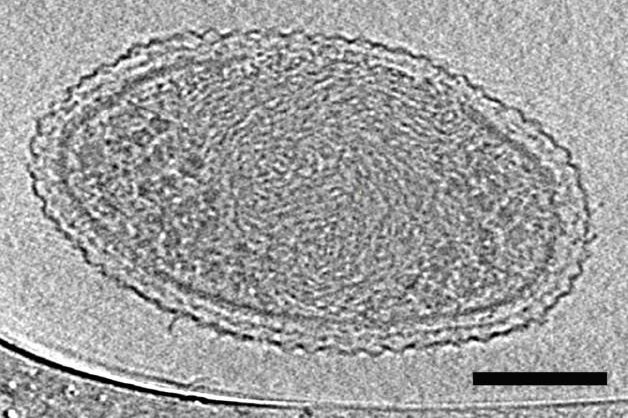Microscope image of the newly detailed ultra-small bacterial cell. Photo by Berkeley Lab
BERKELEY, Calif., March 2 (UPI) -- Over the last two decades, scientists have gone back and forth on whether or not ultra-small bacteria exist. But now, for the first time, there's photographic proof.
Researchers at Department of Energy's Lawrence Berkeley National Laboratory and the University of California, Berkeley, have captured detailed images of the micro-bacteria. The images, produced by high-powered microscopes, detail what scientists say is an example of life at its smallest state.
"These newly described ultra-small bacteria are an example of a subset of the microbial life on earth that we know almost nothing about," researcher Jill Banfield, an Earth and planetary science professor at Berkeley, explained in a press release. "They're enigmatic."
Scientists say the bacteria are common, and found in most groundwater samples.
"These bacteria are detected in many environments and they probably play important roles in microbial communities and ecosystems," Banfield added. "But we don't yet fully understand what these ultra-small bacteria do."
The cells of the super-small bacteria feature an average volume of 0.009 cubic microns. For perspective, scientists say as many as 150,000 cells of the newly detailed bacteria could fit on the end of a strand of human hair.
Scientists used a filter that combs out any particles or organisms larger than 0.2 microns, and then used a newly developed cryo plunger to flash-freeze the tiny bacteria for transport to the lab.
Detailed genetic analysis showed that the bacteria's genome lacks many important functions, which scientists say means the cells likely need to rely on each other to survive -- existing in groups. Imagery shows that the cells are outfitted with tiny appendages called pili that likely allow them to derive support from their cell neighbors.
"There isn't a consensus over how small a free-living organism can be, and what the space optimization strategies may be for a cell at the lower size limit for life," said co-author Birgit Luef. "Our research is a significant step in characterizing the size, shape, and internal structure of ultra-small cells."
The new research, funded by the Department of Energy's Office of Science, was published Monday in the journal Nature Communications.















